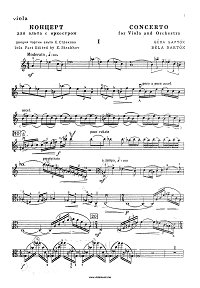
Bartok Viola Concerto Piano Pdfs
Home Sheet Music Viola w/Piano; Bartok, Bela - Viola Concerto Sz 128 Viola and Piano Reduction - Revised by Dellamaggiore and Bartok - Boosey.
Bartok is now considered one of the main Hungarian composers and you'll find here a short Bartok biography. Bartok was an avid collector and analyst of folk music, especially of Hungarian, Rumanian and Slovak tradition. He even recorded some village music with the first phonographs available.
Folk music was his love through all his life and inspired his compositional style. Bartok's life before the Viola Concerto From a very early age Bartok showed a musical talent, encouraged by his parents. He was born on 25th March 1881 and at 11, in 1892, he made his first public appearance as a pianist and after some attempts at the composition of some chamber music works, at 18 he entered the Budapest academy of music to study piano and composition. Soon he attracted attention as a pianist. Later he led the life of a travelling performer and began to develop an interest in peasant music and, after hearing a Transylvanian maid singing, he decided to collect the best Hungarian tunes and write piano accompaniment to make them 'art-songs'. In 1905 Bartok met Zoltan Kodaly who shared his interest in folk music. They developed a lasting relationship and planned to collect a complete collection of folk songs, seeing the danger that traditional music would otherwise soon be lost.
He did several trips to the Eastern parts of the Austro-Hungarian Empire, recording and transcribing peasant songs. Keygen php maker 11 alive 2. Other composers in the past had an interest in folk music, transcribed it and used it in their own music.
What I find particularly interesting about Bartok's activity in this is that he actually recorded village people singing and playing their own traditional music in their villages, during parties or other occasions. I heard some of these original old recordings of violin music and I recognised some of those tunes used by Bartok in his orchestral folk dances. In folk music Bartok also saw a view to renew his own composition style. In 1909 he started teaching piano at the Budapest Academy, where he remained until 1934. In his compositions Bartok started to integrate more and more folk materials.
Folk music was always his love, and he collected and prepared for publication Hungarian, Romanian and also Berber songs from Algeria where he travelled to. He also studied Arabic, Ukrainian and Persian music. This was his main activity for about six years during which Bartok retired from public musical life. This happened from 1912 to the end of the first world war. As Bartok was unfit for military service he and Kodaly were asked to collected folk songs from the soldiers: the songs were later performed in a patriotic concert in 1918 in Vienna. After the war, Bartok re-started his career as a concert pianist and with violinists, promoting also his own works. Later Bartok visited Italy several times and deepened his knowledge of Italian Baroque composers, transcribing and performing their keyboard works.
In 1928 he did his first American concert tour that lasted two months. At that time he also travelled and performed in the Soviet Union and many European countries. In 1934 Bartok was able to leave the teaching position to work as an ethnomusicologist. At the Academy of Sciences he could complete what he had planned many years before with Kodaly: a full collection of Hungarian folk music. When the collection was finished it included about 14,000 pieces. When Austria was annexed to Germany by Hitler this affected Bartok, so he changed publisher and started thinking of sending his valuable manuscript to a safe place, worried that also Hungary might be occupied by the Nazis.
Multi-factor authentication allows IT to improve the security of the PC by implementing multiple hardened factors that both improve the security of the system and improve ease of use for the user. Vreveal 3 premium license key. How Intel’s Collaborative Care Solutions Benefit Your Organization Our solutions leverage an innovative software solution that seamlessly integrates multiple hospital IT systems onto one high-performance technology platform, ultimately creating a real-time, interoperable health system. IT Departments Leverage the technology you need to lead a real-time, interoperable health system. Providers Seamlessly integrate multiple hospital IT systems onto one high-performance technology platform with innovative software solutions.
So he eventually sent them to the USA and later he himself and his family emigrated there in 1940. Bartok spent his final years there, in difficult financial and health conditions, giving some performances, still working on more folk music, teaching and composing. His last works were concertos: one for orchestra, one for violin and our viola concerto. Origin of Bartok Viola Concerto As already said, it is thanks to William Primrose if Bartok's viola concerto exists. Indeed, he commissioned Bartok to write it and paid for it. At that time, in 1945, when Primrose asked Bartok to compose a concerto for him, Bartok was an 'obscure composer', as Primrose defines him, at least in the USA and to the big audience, so it was brave of Primrose to ask him to compose a concerto for viola.
Most people thought that he had made a mistake in commissioning him a viola concerto. Bartok was having a difficult time in the United States of America, where he had moved during the second world war. Primrose says that Bartok initially wasn't sure about writing a viola concerto, as he didn't know the viola possibilities as a solo instrument well enough.